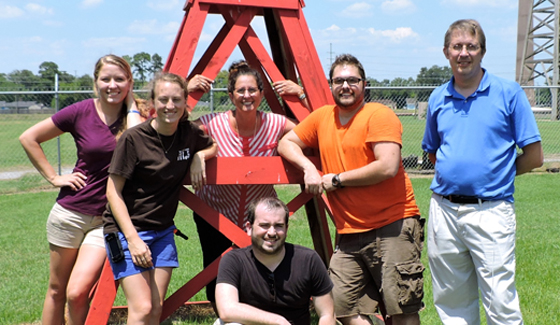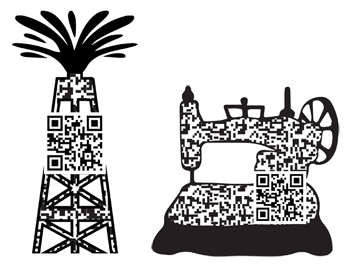Deaf Studies and Deaf Education department members create ASL video tours for local museums

Growing up in Beaumont in the 1960s as the daughter of Deaf parents, Kim Hunt witnessed firsthand the lack of access to communication as they visited public places and events. It became her dream to make museums and events accessible for Deaf residents and visitors to her hometown.
To turn this dream into a reality, Hunt, now a nationally certified interpreter of American Sign Language, partnered with Cain Chiasson, an instructor and doctoral candidate in the Department of Deaf Studies and Deaf Education at Lamar University, to found Virtual QR Tours. The mission of this research project is to establish ASL tours in museums throughout the state of Texas and beyond.
 In the project, Quick Response matrix-style barcodes, called “QR codes,” are printed on museum exhibits and are used to link patrons to videotaped content via a smartphone or tablet. The videos explain the museum's exhibits in ASL as well as in spoken and written English. Last fall, Chiasson and Hunt and their team created QR tours for the Fire Museum of Texas in Beaumont. The team recently completed filming at the Spindletop-Gladys City Boomtown Museum on the campus of Lamar University. Virtual QR tours are designed to be a permanent museum feature.
In the project, Quick Response matrix-style barcodes, called “QR codes,” are printed on museum exhibits and are used to link patrons to videotaped content via a smartphone or tablet. The videos explain the museum's exhibits in ASL as well as in spoken and written English. Last fall, Chiasson and Hunt and their team created QR tours for the Fire Museum of Texas in Beaumont. The team recently completed filming at the Spindletop-Gladys City Boomtown Museum on the campus of Lamar University. Virtual QR tours are designed to be a permanent museum feature.
“This project for me is a way of giving back to the community by providing an under-serviced minority with unprecedented access to public spaces,” said Chiasson. “The best part for me so far has been people who have grown up in the Golden Triangle telling me that they learned new information about Spindletop or the Fire Museum even though they have been coming to these museums since they were children.”
Chiasson’s work on the tours is part of the doctoral research he is conducting in pursuit of the Ed.D. in Deaf Studies and Deaf Education at LU. His dissertation is titled, “Assessing the feasibility of using QR codes to provide bilingual access for printed materials."
“The Department of Deaf Studies and Deaf Education is excited about the QR Tours that are being set up in museums locally,” said Diane Clark, department chair. “Cain Chiasson and his team have worked long and hard to provide access to the Deaf community to these important historical sites. One of the goals of our department is to create strong ties between the local Deaf community and LU students; Cain's work makes these connections strong and enjoyable.”
The time-intensive process to create the ASL videos begins with Chiasson, Hunt, and an “an army of undergraduate students,” according to Chiasson, filming museum docents on location. LU students assist by moving and setting up lighting and sound equipment from station to station. The filming process usually takes between eight to ten hours for small to medium-sized museums.
When filming of the docent is complete, Hunt and Chiasson collaborate with a professional ASL interpreter/actor to translate the material in the docent videos into sign language. The two videos (those of the docent and ASL interpreter) are then digitally combined so that they appear side-by-side onscreen when someone accesses the QR code. Next the team subtitles the videos. When editing and captioning are complete, they upload the videos to YouTube and create QR codes for patrons to scan. The QR codes are then printed and hung at each museum exhibit.
“Having a permanent tour that provides information in American Sign Language is paramount to giving Deaf/Hard of Hearing people equal access,” said Chiasson. “Some people argue that the text that is provided at each exhibit is equivalent to the audio tours that people of normal hearing can rent, but have you ever gone to a museum and read all of the text? The goal of this project is not only to provide access to the information but also to provide an enjoyable experience.”
Virtual QR Tours launched at the Fire Museum of Southeast Texas in October 2015 with more than 200 community members in attendance. The grand opening of the tours at Spindletop is planned for fall 2016, by which time the museum will have free wi-fi access. But the team has already offered a preview of the content to a tour group of senior citizens from Houston’s Woodhaven Baptist Deaf Church.
“We wanted to have the tour ready for them since they are our target audience, and we thought it would be a nice showcase of what LU does for the community,” said Chiasson. “We also thought it would be a great way to welcome them to Beaumont.”
“The preview at Spindletop was a success due not only to Cain and his team's work, but to the LU faculty and students who came to help with the tours and engage with a group of Deaf seniors from Houston,” said Clark.
 Chiasson collaborated with Sherry Freyermuth, assistant professor in the Department of Art, and her graphic design class to create the artwork that will frame the QR codes at Spindletop (two examples of which are pictured to the right).
Chiasson collaborated with Sherry Freyermuth, assistant professor in the Department of Art, and her graphic design class to create the artwork that will frame the QR codes at Spindletop (two examples of which are pictured to the right).
“Sherry Freyermuth and her graphic design class did a tremendous job in designing the artwork for Spindletop,” said Chiasson, owner and creative director of Virtual QR Tours. “And I also want to acknowledge Kim Hunt, whose dream of providing access for her Deaf family and friends created the foundation for this project.”
Hunt provides creative input for Virtual QR Tours and was also LU’s first full-time staff ASL interpreter, from 2001- 06. She has worked as a professional interpreter for more than 28 years in the areas of law, education, medicine, community, religious and video-relay interpreting.
Chiasson is currently in discussions with the city of San Antonio to possibly provide ASL tours of the Riverwalk. Though no plans have yet been set, he is also discussing expanding local museum coverage to the Clifton Steamboat Museum and the Beaumont Children’s Museum.
Pictured at top:
Team of LU students and others post filming ASL video tours of Spindletop Museum. Left to right: Dorothy Radebaugh, of Leander, Texas, ASL-interpreting major; Jessica Romine, Port Arthur, ASL-interpreting tract; Kim Hunt, ASL/English interpreter; Cain Chiasson, LU instructor; and Troy Gray, Spindletop Museum director. Seated at the front: Jacob Thornton, Corsicana, master’s student in counseling and member of the film crew and a Deaf interpreter. Photo courtesy of Cain Chiasson.


